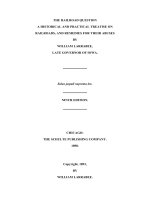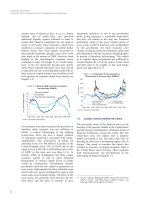KNIT DYEING FAULTS AND REMEDIES
Bạn đang xem bản rút gọn của tài liệu. Xem và tải ngay bản đầy đủ của tài liệu tại đây (1.29 MB, 14 trang )
SOUTHEAST UNIVERSIT Y
Department of Textile Engineering
Knit dyeing faults & remedies
SOUTHEAST UNIVERSIT Y
Department of Textile Engineering
Knit dyeing faults & remedies
Prepared By : Mazadul Hasan
sheshir
ID: 2010000400008
13th Batch
Wet Processing Technology
Email:
Southeast University
Southeast University
Department Of Textile Engineering
I/A 251,252 Tejgaon Dhaka Bangladesh
Why Dyeing Faults occurs:
Why Dyeing Faults occurs:
While dyeing, large volume of dyestuff, thickening agent and
small amount of water are used. Many textile chemicals like
Dispersing agent, Leveling agent, Acid buffer etc are used during
the process. The dyestuff have to be either fermented (for natural
dye) or chemically reduced (for synthetic vat and sulfur dyes) before
being applied. This makes the dye soluble so that it can be
absorbed by the fiber. Direct dyes are water soluble and can be
applied directly to the fiber from an aqueous solution. Most other
classes of synthetic dyes, other than vat and sulfur dyes, are also
applied in this way.
Example of Dyeing faults
Uneven dyeing.
Running shade.
Batch to batch shade variation.
Patchy dyeing effect.
Roll to roll variation or Meter to meter variation.
Crease / Wrinkle mark.
Dye spot.
Softener mark.
Fabric hole.
Uneven dyeing.
Causes:
• Uneven pretreatment (uneven scouring & bleaching).
• Improper color dosing.
Remedy:
• By ensuring even pretreatment.
• Proper dosing of dyes and chemicals.
Batch to Batch Shade variation:
Causes:
• Fluctuation of Temperature.
• Improper dosing time of dyes & chemicals.
Remedies:
• Use standard dyes and chemicals.
• Maintain the same liquor ratio.
Patchy dyeing effect.
Causes:
• Faulty injection of alkali.
• Due to improper salt addition.
Remedy:
• Proper dosing of dyes and chemicals.
• Heat should be same throughout the dye liquor.
Roll to roll variation or Meter to Meter variation:
Causes:
• Poor migration property of dyes.
• Improper dyes solubility
Remedies:
• Use standard dyes and chemicals.
• Proper m/c speed.
Crease mark:
Causes:
• If pump pressure & reel speed is not equal.
• Poor opening of the fabric rope.
Remedy:
• Maintaining proper reel sped & pump speed.
• Lower rate rising and cooling the temperature.
Dye spot:
Causes:
• Improper Dissolving of dye particle in bath.
• Improper Dissolving of caustic soda particle in bath.
Remedies:
• By proper dissolving of dyes & chemicals.
• By passing the dissolved dyestuff through a fine
stainless steel mesh strainer, so that the large un-dissolved particles are removed.
Crease/Wrinkle mark:
Causes:
• Poor opening of the fabric rope.
• Shock cooling of synthetic material.
Remedies:
• Maintaining proper reel speed & pump speed.
• Lower rate rising and cooling the temperature.
Softener Mark:
Causes:
• Improper mixing of the Softener.
• Improper running time of the fabric during
application of softener.
Remedies:
• Maintaining proper reel sped & pump speed.
• Proper Mixing of the softener before addition.
Fabric hole.
causes:
• More acid of knit fabric in the dyeing section.
• Temperature highly.
Remedy:
• Use standard Acid.
• Proper dosing of Acid.
Some other faults
1. Long mark
8. Fly we
2. Loop mark
9. Brush problem
3. Dhappa spot
10.Uneven even hairiness
4. Yellow spot
11. Water spot
5. Iron spot
12. soda spot
6. Out color
13. Lycra out
7. Enzyme dust
14. Patta fault
Finishing faults in the Textile:
Ballooning shape.
Radish shade.
Squeezer mark.
Dia mark.
Dirty spot.
Compaction /Press mark.
Compacting hole.
Crease mark.
Calendaring crease.
Oil Spot.
Improper shrinkage.
Bowing:
Crease Streak:
Fabric Fault Inspection:
The inspection of fabric is a procedure by which the defects of
fabric are identified and fabric is classified according to degree
or intensity of defects. The fabric inspection is done for both grey
and finished fabric.
Fabric inspection :
Two ways of grey fabric inspection used to done bya) Auto turning fabric inspection m/c.
b) Varivide colour assessment cabinet –2
D-65, TL-84, TL-83, Florescent,
UV.
Conclusion
Fabric and Garments defect are the most important in garments
factory. It is very harmful for garments industries. Considering the
objective of the work, a systematic investigation on ‘Knit dyeing
Faults and Remedies’ were performed in the training period. All the
activities had been done maintaining in sequence of the machinery
of the production. There are many common defects which are
continually detected in the fabrics which are described in
Methodology. The purpose of our project is identifying the faults of
fabric and garments. We were identifying the fabric and garments
faults very closely and very carefully.









